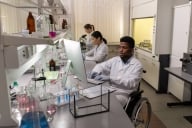You have /5 articles left.
Sign up for a free account or log in.
August is the time when sociologists and political scientists travel from around the country to attend their respective disciplines’ annual conferences. For sociologists like me, that’s the American Sociological Association’s annual meeting, starting this Saturday in New York City. For political scientists, it’s the American Political Science Association’s meeting, being held this year in Washington at the end of the month.
Joining such professional associations is important for a number of reasons: professional development, networking and keeping abreast of the field, among others. Likewise, participating in their annual meetings is a time to meet with -- whether for the first time or with long-standing friends and colleagues -- scholars from across the country and hear presentations on cutting-edge research.
But navigating a conference that attracts thousands of academics can be intimating. Here are three tips -- primarily for graduate students going to these conferences for the first few times -- that can ease your anxiety and help you get the most out of attending the conference.
Go to a business meeting. Since professional organizations like the ASA and APSA are large, they are often divided into smaller entities as a way to facilitate interaction and scholarly communication among people working on similar topics. For example, the ASA is organized around sections, which “are officially recognized groups of sociologists who share a common interest in a specific topic.” You can currently join and participate in as many as 52 different sections, including, among many others, the Sociology of Culture; Global and Transnational Sociology; Environmental Sociology; Aging and the Life Course; and Crime, Law, and Deviance.
Thus, joining the professional association is just the first step of being a professional academic. Getting involved in section(s), in the case of the ASA, is the next step. These are places where the leaders in the field are participating and shaping debate.
At the ASA, each section has a business meeting that is open for anyone to attend, although it is geared toward section members. Business meetings often revolve around the following activities, among others:
- updating members on council activities during the past year and at the meeting,
- handing out awards,
- soliciting ideas for next year’s section panels,
- asking for volunteers for various committees and work the section does throughout the year, and
- officially handing over leadership from the outgoing chair of the section to the incoming chair.
Attending business meetings will give you a sense of what sections actually do. It is a behind-the-scenes look at the service work of academics engaged in furthering the profession and the field vis-à-vis the disciplinary association. In addition, attending a business meeting is a great way to become involved in the section, because there is often a call for volunteers.
Volunteering for a section is important for several reasons. First, you get to meet and connect with others in the field. Conversely, it allows people to get to know you and your work. It helps you forge professional relationships and heightens the visibility of your work, both of which are important in the tenure process.
Volunteering also provides professional development and leadership opportunities, where you get a chance to become involved and help shape and advance the field. Take, for example, the ASA culture section, where I am a council member. We had a budget surplus, and I had the idea to use that surplus to institutionalize five $100 awards for graduate student travel each year. Similarly, as chair of the membership committee of the Community and Urban Sociology section, I helped spearhead two new awards: one on publicly engaged research and another for exceptional teaching, both of which recognize the diverse ways that faculty members, particularly those from underrepresented groups, contribute to the profession.
Reach out and meet others. This may seem obvious, but figuring out how to meet others at conferences can be a bit challenging. Many of ASA’s sections offer mentoring programs that match senior scholars, junior faculty and graduate students. Those programs vary in size and format and could include, say, one-on-one matches between faculty members and grad students or mentoring groups. No matter the format, the aim is similar: to connect junior scholars with more established ones to help them meet people in their given subfield and encourage their professional development. Calls to participate in any mentoring program often occur a few months in advance of the meeting so the organizers can plan for the venue and match participants. If it is too late for you to sign up to participate this year, don’t fret! You can meet people other ways.
Another common approach is to email people before the meeting and ask to grab coffee. Simple, right? Right, except it can be intimidating to email a total stranger. I recommend emailing a person whose work you know and admire and who is one or two steps ahead of you in the profession. For instance, a first- or second-year graduate student can email an advanced graduate student at another university, or a graduate student at any stage can email a postdoc or assistant professor. Emailing someone a bit more advanced than you demonstrates you’ve done your homework, are prepared and thoughtful, and are not just randomly reaching out. It also allows you to gather more specific advice from people who recently were at your stage in their career.
You should remember a few important things when emailing people: first, academics are busy. Most people will respond, but some will not. Try not to take it personally. Second, always include a reason why you are emailing them -- some kind of connection, whether a similarity in topic or method -- and, most important, what you want to discuss when you meet with them. Do you want advice on going on the job market? On how to transform a thesis into a publication? On how to get through the general exam process? Think about what it is you need or want to learn, as Kerry Ann Rockquemore advises in her explanation of mentoring and the mentor map. Even if you just want to get together to talk about one of their recent papers, give the person a sense of what to expect in advance of the meeting.
Finally, many conference receptions are open to anyone. For example, the ASA holds a general welcome reception. Other ASA receptions are aimed at particular communities such as the Minority Fellowship Program Benefit, First-Generation and Working-Class Sociologists, and Teaching Enhancement Fund receptions. ASA sections also host receptions, whether on their own or with other sections. And even some departments host official or unofficial gatherings for their grad students, postdocs, faculty members and alums. If you have any connection to or interest in any of the receptions, take advantage of the (often free) drinks and snacks, and go!
Attend sessions and/or participate in activities. Again, this may seem obvious, but sometimes people only attend their own session and skip the rest of the conference. What’s more, the programs of disciplinary conferences can be overwhelming. How do you figure out what to attend when there are about 600 sessions that cover almost 3,000 papers?
There are a few ways. The ASA program consists of many different types of sessions:
- author meets critic, where a handful of scholars critique a book,
- regular sessions on different topics,
- sessions hosted by sections,
- thematic sessions organized around the conference theme, and
- presidential panels.
If you’re drawn to the content of a particular section, you could begin by searching for that section’s panels. If you are interested in the general conference theme -- this year’s ASA is on “Engaging Social Justice for a Better World” -- you can look up the associated panels. Another way to select which sessions to attend is to think about the people whose work you like and search for panels where they will be presenting.
In addition to sessions, mentoring programs and receptions, you can pursue other ways to participate in the conference. For example, you can attend preconferences organized along themes or by sections the day before the upcoming ASA conference, as well as sign up for various tours.
If it is your first time attending a conference, you probably won’t be able to follow all the suggestions I’ve given, and that’s OK. Start small. Pick just one or two as you plan for your disciplinary conference, whether the ASA, APSA or one that will be held later in the year. I hope they will help you make the most of your time.




